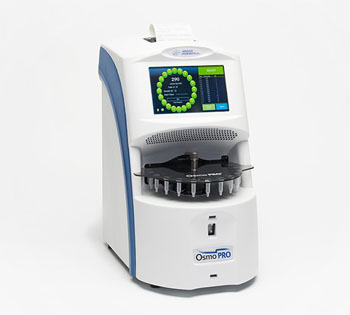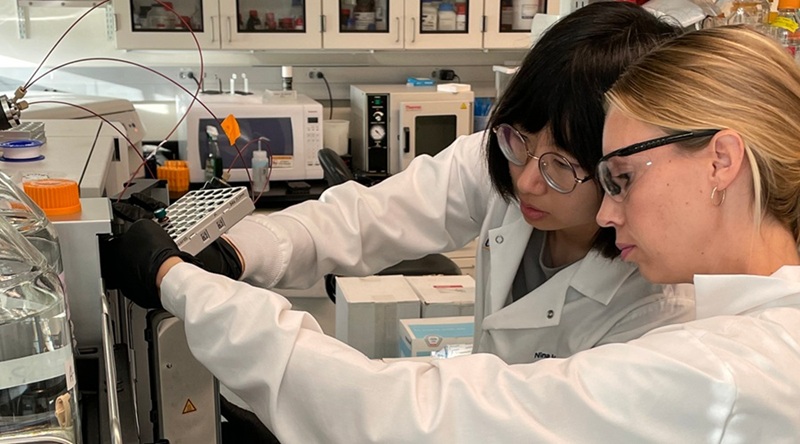Multi Sample Osmometer Improves Testing Efficiency
|
By LabMedica International staff writers Posted on 03 Aug 2016 |

Image: The OsmoPRO multi-sample osmometer for automated testing (Photo courtesy of Advanced Instruments).
A novel 20-position micro sample osmometer improves laboratory efficiency, productivity, and workflow by reducing sample turn-around time.
The OsmoPRO Multi-Sample Osmometer for automated osmolality testing is designed to analyze a variety of complex aqueous mixtures, including blood, serum, plasma, urine, cell culture media, drug formulations, and biological cell therapies, using a small, 20 μL sample size. Samples can be analyzed one at a time, or batch processed depending on workflow demands. Timesaving features include an intuitive touch screen, automated processing, and the ability to run unattended. The device also uses the freezing point depression method to deliver results in just two minutes.
The OsmoPRO can be used in a variety of laboratory applications including clinical diagnostics, formulation development, bioprocess monitoring and process control, industrial, environmental, and finished product quality control. An integrated barcode scanner provides positive sample identification to reduce transcription errors, with data management and transfer handled via the on-board printer or by exporting the data using an ethernet connection and multiple USB ports. The OsmoPRO multi-sample osmometer, a product of Advanced Instruments (Norwood, MA, USA), will be presented at AACC 2016.
“OsmoPRO incorporates more than 60 years of applied technology and expertise from Advanced Instruments, the industry leader in the field of osmometry,” said Peter Costas, vice president of sales and marketing at Advanced Instruments. “OsmoPRO replaces the Advanced Model 2020 osmometer, which has been an extremely popular and reliable osmometer used in thousands of laboratories worldwide, and represents Advanced Instruments commitment to quality and innovation in the field of osmometry”.
Osmometers are used for measuring the osmotic strength of a solution, colloid, or compound, or determining the molecular weight of unknown compounds and polymers. Several techniques can be used, including vapor pressure depression to determine the concentration of osmotically active particles; determining the osmotic pressure of a solution separated from pure solvent by a semipermeable membrane; and freezing point depression to determine osmotically active compounds in a solution.
The American Association for Clinical Chemistry (AACC; Washington, DC, USA) is an international scientific/medical society of over 8,000 clinical laboratory professionals, physicians, research scientists and more. The AACC annual meeting, which will be held from July 31st to August 4th at the Pennsylvania Convention Center in Philadelphia (USA), features five days of educational sessions on scientific, clinical, technical and management challenges facing laboratory professionals, as well as the world’s largest Clinical Lab Expo.
Related Links:
Advanced Instruments
American Association for Clinical Chemistry
The OsmoPRO Multi-Sample Osmometer for automated osmolality testing is designed to analyze a variety of complex aqueous mixtures, including blood, serum, plasma, urine, cell culture media, drug formulations, and biological cell therapies, using a small, 20 μL sample size. Samples can be analyzed one at a time, or batch processed depending on workflow demands. Timesaving features include an intuitive touch screen, automated processing, and the ability to run unattended. The device also uses the freezing point depression method to deliver results in just two minutes.
The OsmoPRO can be used in a variety of laboratory applications including clinical diagnostics, formulation development, bioprocess monitoring and process control, industrial, environmental, and finished product quality control. An integrated barcode scanner provides positive sample identification to reduce transcription errors, with data management and transfer handled via the on-board printer or by exporting the data using an ethernet connection and multiple USB ports. The OsmoPRO multi-sample osmometer, a product of Advanced Instruments (Norwood, MA, USA), will be presented at AACC 2016.
“OsmoPRO incorporates more than 60 years of applied technology and expertise from Advanced Instruments, the industry leader in the field of osmometry,” said Peter Costas, vice president of sales and marketing at Advanced Instruments. “OsmoPRO replaces the Advanced Model 2020 osmometer, which has been an extremely popular and reliable osmometer used in thousands of laboratories worldwide, and represents Advanced Instruments commitment to quality and innovation in the field of osmometry”.
Osmometers are used for measuring the osmotic strength of a solution, colloid, or compound, or determining the molecular weight of unknown compounds and polymers. Several techniques can be used, including vapor pressure depression to determine the concentration of osmotically active particles; determining the osmotic pressure of a solution separated from pure solvent by a semipermeable membrane; and freezing point depression to determine osmotically active compounds in a solution.
The American Association for Clinical Chemistry (AACC; Washington, DC, USA) is an international scientific/medical society of over 8,000 clinical laboratory professionals, physicians, research scientists and more. The AACC annual meeting, which will be held from July 31st to August 4th at the Pennsylvania Convention Center in Philadelphia (USA), features five days of educational sessions on scientific, clinical, technical and management challenges facing laboratory professionals, as well as the world’s largest Clinical Lab Expo.
Related Links:
Advanced Instruments
American Association for Clinical Chemistry
Latest AACC 2016 News
- Molecular Test Detects Three Arboviruses in Plasma Samples
- Derived Exosomal Protein Biomarkers in Alzheimer’s Disease Diagnosis
- New Biochip Array Developed for ApoE4 Classification
- Cell-Free DNA Identifies Liver Transplant Patients with Acute Rejection
- New Method Tested for Early Diagnosis Pediatric Diabetic Nephropathy
- FDA-Cleared Automated Cell Counter for CSF Launched at AACC 2016
- Semen Analysis Portfolio with Two New Products Featured at AACC 2016
- Automation Solutions for Clinical Diagnostic Equipment Showcased at AACC 2016
- New Tubes Designed for Medium Sample Volumes
- Innovative Information System Optimizes Laboratory Processes
- Innovative eLearning Interface Seamlessly Connects Competency Data
- Cloud-Based Connectivity Platform Advances Decentralized Healthcare
- Adhesives Research to Present Hydrophilic Adhesive Technologies
- Point-of-Care Immunoassay Analyzer on Display at AACC Annual Meeting
- Assay for Determination of 17-OH Progesterone to Be Featured at AACC Annual Meeting
- Fully Automated HbA1c Analyzer Available for Inspection at AACC Annual Meeting
Channels
Clinical Chemistry
view channel
Online Tool Detects Drug Exposure Directly from Patient Samples
Doctors often rely on patient interviews and medical records to determine what medications a person has taken, but this information is frequently incomplete. People may forget drugs they used, take over-the-counter... Read more
Chemical Imaging Probe Could Track and Treat Prostate Cancer
Prostate cancer remains a leading cause of illness and death among men, with many patients eventually developing resistance to standard hormone-blocking therapies. These drugs often lose effectiveness... Read moreMolecular Diagnostics
view channel
New 15-Minute Hepatitis C Test Paves Way for Same-Day Treatment
Chronic hepatitis C infection affects an estimated 50 million people worldwide and causes around 242,000 deaths each year, largely due to cirrhosis and liver cancer. Although the infection is curable with... Read more
Ovarian Cancer Assay Outperforms Traditional Tests in Early Disease Detection
Globally, ovarian cancer is one of the deadliest cancers affecting women. Traditionally, early diagnosis of ovarian cancer has been challenging. Many ovarian cancers are diagnosed only after they have... Read moreHematology
view channel
MRD Tests Could Predict Survival in Leukemia Patients
Acute myeloid leukemia is an aggressive blood cancer that disrupts normal blood cell production and often relapses even after intensive treatment. Clinicians currently lack early, reliable markers to predict... Read more
Platelet Activity Blood Test in Middle Age Could Identify Early Alzheimer’s Risk
Early detection of Alzheimer’s disease remains one of the biggest unmet needs in neurology, particularly because the biological changes underlying the disorder begin decades before memory symptoms appear.... Read more
Microvesicles Measurement Could Detect Vascular Injury in Sickle Cell Disease Patients
Assessing disease severity in sickle cell disease (SCD) remains challenging, especially when trying to predict hemolysis, vascular injury, and risk of complications such as vaso-occlusive crises.... Read more
ADLM’s New Coagulation Testing Guidance to Improve Care for Patients on Blood Thinners
Direct oral anticoagulants (DOACs) are one of the most common types of blood thinners. Patients take them to prevent a host of complications that could arise from blood clotting, including stroke, deep... Read moreImmunology
view channel
Routine Blood Test Can Predict Who Benefits Most from CAR T-Cell Therapy
CAR T-cell therapy has transformed treatment for patients with relapsed or treatment-resistant non-Hodgkin lymphoma, but many patients eventually relapse despite an initial response. Clinicians currently... Read more
New Test Distinguishes Vaccine-Induced False Positives from Active HIV Infection
Since HIV was identified in 1983, more than 91 million people have contracted the virus, and over 44 million have died from related causes. Today, nearly 40 million individuals worldwide live with HIV-1,... Read more
Gene Signature Test Predicts Response to Key Breast Cancer Treatment
DK4/6 inhibitors paired with hormone therapy have become a cornerstone treatment for advanced HR+/HER2– breast cancer, slowing tumor growth by blocking key proteins that drive cell division.... Read more
Chip Captures Cancer Cells from Blood to Help Select Right Breast Cancer Treatment
Ductal carcinoma in situ (DCIS) accounts for about a quarter of all breast cancer cases and generally carries a good prognosis. This non-invasive form of the disease may or may not become life-threatening.... Read moreMicrobiology
view channel
Blood-Based Diagnostic Method Could Identify Pediatric LRTIs
Lower-respiratory tract infections (LRTIs) are a leading cause of illness and death worldwide, and pneumonia is the leading infectious cause of death in children under five, claiming the lives of over... Read more
Rapid Diagnostic Test Matches Gold Standard for Sepsis Detection
Sepsis kills 11 million people worldwide every year and generates massive healthcare costs. In the USA and Europe alone, sepsis accounts for USD 100 billion in annual hospitalization expenses.... Read moreRapid POC Tuberculosis Test Provides Results Within 15 Minutes
Tuberculosis remains one of the world’s deadliest infectious diseases, and reducing new cases depends on identifying individuals with latent infection before it progresses. Current diagnostic tools often... Read more
Rapid Assay Identifies Bloodstream Infection Pathogens Directly from Patient Samples
Bloodstream infections in sepsis progress quickly and demand rapid, precise diagnosis. Current blood-culture methods often take one to five days to identify the pathogen, leaving clinicians to treat blindly... Read morePathology
view channel
Rapid Low-Cost Tests Can Prevent Child Deaths from Contaminated Medicinal Syrups
Medicinal syrups contaminated with toxic chemicals have caused the deaths of hundreds of children worldwide, exposing a critical gap in how these products are tested before reaching patients.... Read more
Tumor Signals in Saliva and Blood Enable Non-Invasive Monitoring of Head and Neck Cancer
Head and neck cancers are among the most aggressive malignancies worldwide, with nearly 900,000 new cases diagnosed each year. Monitoring these cancers for recurrence or relapse typically relies on tissue... Read more
Common Health Issues Can Influence New Blood Tests for Alzheimer’s Disease
Blood-based tests for Alzheimer’s disease are transforming diagnosis by offering a simpler alternative to spinal taps and brain imaging. However, many people evaluated at memory clinics also live with... Read more
Blood Test Formula Identifies Chronic Liver Disease Patients with Higher Cancer Risk
Chronic liver disease affects millions worldwide and can progress silently to hepatocellular carcinoma (HCC), one of the deadliest cancers globally. While surveillance guidelines exist for patients with... Read moreTechnology
view channel
Machine Learning Models Diagnose ALS Earlier Through Blood Biomarkers
Amyotrophic lateral sclerosis (ALS) is a rapidly progressive neurodegenerative disease that is notoriously difficult to diagnose in its early stages. Early symptoms often overlap with other neurological... Read more
Artificial Intelligence Model Could Accelerate Rare Disease Diagnosis
Identifying which genetic variants actually cause disease remains one of the biggest challenges in genomic medicine. Each person carries tens of thousands of DNA changes, yet only a few meaningfully alter... Read moreIndustry
view channel
Abbott Acquires Cancer-Screening Company Exact Sciences
Abbott (Abbott Park, IL, USA) has entered into a definitive agreement to acquire Exact Sciences (Madison, WI, USA), enabling it to enter and lead in fast-growing cancer diagnostics segments.... Read more




















